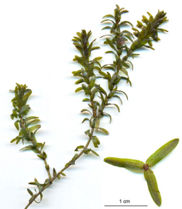Difference between revisions of "Elodea canadensis"
PsiPro bot (talk | contribs) m (clean up) |
(No difference)
|
Latest revision as of 00:38, 14 February 2011
This article has been flagged as being in an improper format. You can help The Aquarium Wiki by fixing it. Don't be shy!
These articles pertain to the proper formatting of species profiles or listings: Help:Contents/Editing
Elodea canadensis is a perennial aquatic plant, or submergent macrophyte, native to most of North America. It is closely related to Elodea nuttallii, which generally has narrower leaves under 2 mm broad. It is usually fairly easy to distinguish from its relatives, like the Brazilian Elodea densa and Hydrilla verticillata. These all have leaves in whorls around the stem; however, Elodea canadensis usually has three leaves per whorl, whereas Elodea Densa and Hydrilla usually have four or more leaves per whorl. Elodea densa is also a larger, bushier plant with longer leaves
Common Names[edit]
Elodea canadensis is commonly known as Canadian waterweed, Canadian pondweed, American waterweed, or American pondweed.
Growth[edit]
Young plants initially start with a seedling stem with roots growing in mud at the bottom of the water; further adventitious roots are produced at intervals along the stem, which may hang free in the water or anchor into the bottom. It grows indefinitely at the stem tips, and single specimens may reach lengths of 3 m or more. The leaves are bright green, 6–17 mm long and 1–4 mm broad, borne in whorls of three (rarely two or four) round the stem. It lives entirely underwater, the only exception being the small white or pale purple flowers which float at the surface and are attached to the plant by delicate stalks. It is dioecious, with male and female flowers on different plants. The flowers have three small white petals; male flowers have 4.5–5 mm petals and nine stamens, female flowers have 2–3 mm petals and three fused carpels. The fruit is an ovoid capsule, about 6 mm long containing several seeds that ripen underwater. The seeds are 4–5 mm long, fusiform, glabrous (round), and narrowly cylindrical. It grows rapidly in favorable conditions and can choke shallow ponds, canals, and the margins of some slow-flowing rivers. It requires summer water temperatures of 10-25 °C and moderate to bright lighting.
